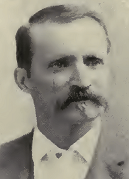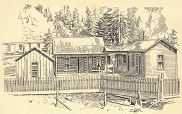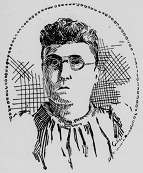Nicholas C. Creede facts for kids
Quick facts for kids
Nicholas C. Creede
|
|
|---|---|
 |
|
| Born |
William Harvey
1843 |
| Died | July 12, 1897 Los Angeles, CA
|
| Occupation | Prospector |
| Years active | 1862-1893 |
Nicholas C. Creede (born William Harvey, 1843 – July 12, 1897) was an American prospector. He became famous for finding valuable mineral veins, like the Holy Moses and Amethyst, near what is now Creede, Colorado. These discoveries happened in the late 1880s and early 1890s.
Contents
Early Life and Army Days
Nicholas C. Creede was born William "Billy" Harvey in 1843 near Fort Wayne, Indiana. When he was two, his family moved to Jasper County in Iowa Territory. There, they worked on a farm.
Working for the Army
As a teenager, Creede worked for the U.S. Army. He found the work boring. In 1862, at age 19, he joined the United States Army. He served for seven years as a scout with the Pawnee people. They helped in campaigns against the Sioux.
During this time, he traveled through Nebraska, Colorado, Wyoming, and Montana. He also explored the Badlands of the Dakotas. He was in the Black Hills when gold was found there. This sparked his interest in looking for minerals.
Changing His Name
In 1870, Creede left the army and went back to Iowa. He hoped to marry a girl he liked. But when he returned, he found she had married his brother. This event upset Billy Harvey very much. He then changed his name to Nicholas "Nic" C. Creede. This also made him even more determined to become a prospector.
Life as a Prospector
For the next 20 years, Creede traveled across the Rocky Mountains. He was always looking for valuable minerals. Sometimes he would find enough to sell and live comfortably for a year. More often, he was broke. He had to work odd jobs to earn money to keep prospecting. He usually worked with one or more partners.
First Big Finds
Creede's first important discovery was in 1878 in Chaffee County, Colorado. He found a mine he called the Monarch. It was near today's Monarch Pass. Like many prospectors, he sold the Monarch for a small amount. He then found another vein he named the Bonanza. He sold it for US$20,000. This money allowed him to visit other mining areas. He learned more about mining, minerals, and prospecting.
More Discoveries
Creede's next major find was the Mammoth mine in May 1890. It was on Campbell Mountain, Colorado. The Mammoth had some rich ore, but it was not a huge discovery. A month later, Creede found the Ethel mine nearby. Once developed, the Ethel shipped some ore, but it was not very high quality.
The Holy Moses and Amethyst Mines
In June 1891, Creede made his biggest discovery yet: the Holy Moses. It was near a place then called Jimtown camp. This find was so rich that it caught the attention of David H. Moffat from Denver. Moffat and his partners leased the Holy Moses from Creede.
Moffat's group was impressed by Creede's skill. They made another deal with him. Creede would continue prospecting, and they would develop the Holy Moses. Creede received US$100 a month. He also got a one-third share of any future discoveries.

This deal was very good for Creede. Soon after finding the Holy Moses, he found the rich Amethyst vein. This was on a claim that another miner had given up. Mines like the Bachelor, Annie Rooney, Sunnyside, and Commodore were later developed on the Amethyst vein.
Creede's share from the Amethyst mining was over a million dollars. Some reports say he earned US$1,000 a day in 1892 from these mines. Soon after the Amethyst vein was found, the Jimtown camp was renamed Creede in his honor.
In March 1892, after the Amethyst discovery, Scientific American magazine interviewed Creede. They described him as quiet, humble, and brave. They said he was generous and spoke few words, but those words showed "great good sense." He was also said to avoid alcohol and gambling.
Life After Becoming Rich
Marriage and New Home
While prospecting near Jimtown camp, Creede met Nancy Louisa Kyles. She was from Birmingham, Alabama. Mrs. Kyles ran a boarding house in Del Norte, Colorado. She knew about the tough life on the frontier and in mining camps.
When Creede became rich, he built a simple log cabin in Creede. Mrs. Kyles worked as his housekeeper while she got a divorce from her husband. She often went with Creede and his young nephew, Sherman Phifer, on prospecting trips.
They married in Las Vegas, New Mexico on May 25, 1893. They bought a small cottage in Pueblo, Colorado. Later, the Creedes bought a large home in Los Angeles and moved there permanently. They lived a comfortable life.
Adopting a Daughter
In August 1895, the Creedes adopted six-month-old Edith Dorothy Hitt Walker. They had no children of their own. Young Dorothy's story was as interesting as the Creedes'.
Dorothy's mother, Edith Waters Walker, had a difficult early life. She wanted to be an actress. Dorothy's father, John Mackay Walters, also had an interesting family background. Their marriage was short. Edith later struggled to support Dorothy.
Mr. Creede heard about Edith's difficulties. He was moved by her story and offered to adopt Dorothy. The adoption was completed in late summer. Edith wanted Dorothy to have a good home because she was worried about her own health.
Challenges in Marriage
Mrs. Creede had health issues and was not able to care for young Dorothy. So, nurses were hired to help with the baby. In February 1896, Miss Maggie Kearny became Dorothy's nurse. Mrs. Creede later claimed that in the summer of 1897, Creede started a relationship with Miss Kearny. Miss Kearny denied this.
In early 1897, Mrs. Creede fired Miss Kearny and had her removed from their Los Angeles home. This made Creede very angry. He had promised to end their marriage if Mrs. Creede did something like that.
On January 4, 1897, Creede asked his wife to accept US$20,000. He wanted her to give up all claims and return to her home in Alabama. Mrs. Creede signed a document agreeing to this. It was understood that Creede would then start divorce proceedings. Miss Kearny returned to the Creede home on January 14.
Creede began divorce proceedings, saying his wife was cruel. Mrs. Creede fought back, asking for half of their property. She returned to Los Angeles to pursue her case. Creede was upset by her presence and had her movements watched.
Death of Nicholas Creede
On the afternoon of July 12, 1897, Creede went to his garden. He lay down on a couch in his summer house. His gardener, F. L. Maas, noticed he seemed weak and had trouble breathing. He didn't tell anyone until Creede's brother-in-law, William M. Phifer, arrived. Mr. Phifer carried Creede into the house and called for a doctor. Despite medical help, Creede died about three hours later.
Creede's Will and Estate
Creede's will left most of his money to his adopted daughter, Dorothy. She would receive it when she turned 25, if she grew up to be a "good, virtuous woman." He also left smaller amounts to his sister, nephew, and brothers. Mrs. Creede was not included in the will. His sister Clara's husband, William Phifer, was named as the executor of the will and Dorothy's guardian.
Creede's estate was valued at US$153,716. This included his property in California. Some estimates said his total wealth was over US$3,000,000.
Legal Battles Over the Estate
After Creede's death, many legal cases followed. A big trial in Los Angeles in early 1898 decided how the estate would be divided. The main questions were:
- Was Mrs. Creede legally married to Mr. Creede?
- Was the separation agreement she signed valid?
- Was the will a fake?
Nancy White (Mrs. Creede) had married several times. Her first husband, George S. Vandever, was thought to have died. But he was still alive when she married Creede. This could have made her marriage to Creede invalid. However, it was discovered that Vandever had divorced Nancy before she married Creede. So, her marriage to Creede was legal.
Mrs. Creede claimed she was forced to sign the separation agreement and was sick at the time. But others said she seemed alert when she signed it. She also claimed she and Creede were business partners and that she helped him find the Amethyst vein.
Mrs. Creede also said that Nicholas Creede's signature on the will was not real. She thought it was stamped and then traced over.
In August 1898, the court decided that Nancy Louise Creede was Nicholas C. Creede's legal wife. However, the court also ruled that the separation agreement she signed was valid. This meant she was not entitled to any part of the estate beyond the US$20,000 she had already received.
Dorothy's Guardianship
Several people wanted to be Dorothy Creede's guardian. William Phifer was named in the will. Mrs. Creede also wanted guardianship. Dorothy's birth mother, Edith Waters Walker, who had recovered from her illness and remarried, also sought guardianship.
William Phifer died before the case was settled. It was also noted that only Mr. Creede had legally adopted Dorothy. The court decided in 1898 that Mrs. Bashford (Dorothy's birth mother) would be her guardian. Dorothy then moved to San Francisco with her mother.
Dorothy's Later Life
In 1901, Dorothy, with her mother's help, was able to get a large part of the estate before she turned 25. She graduated from Tamalpais High School in 1914. She married William Lloyd Ritchie and had a daughter, Edith Romer Ritchie, in 1918.
Dorothy (Mrs. Ritchie) died at age 23 in November 1918. She passed away at St. Francis Hospital from the Spanish flu, which developed from bronchitis. Most of Creede's estate then went to her daughter, and the rest went to her mother, Mrs. Bashford.
Other Lawsuits
Legal battles continued even after Dorothy's guardianship was settled. In 1899, a lawsuit was filed claiming that David H. Moffat and his partners tricked Creede into giving them his stock in the Amethyst Mining Company for free. The lawsuit said that a one-third share in the Amethyst mines was worth over US$5,000,000.
Images for kids






